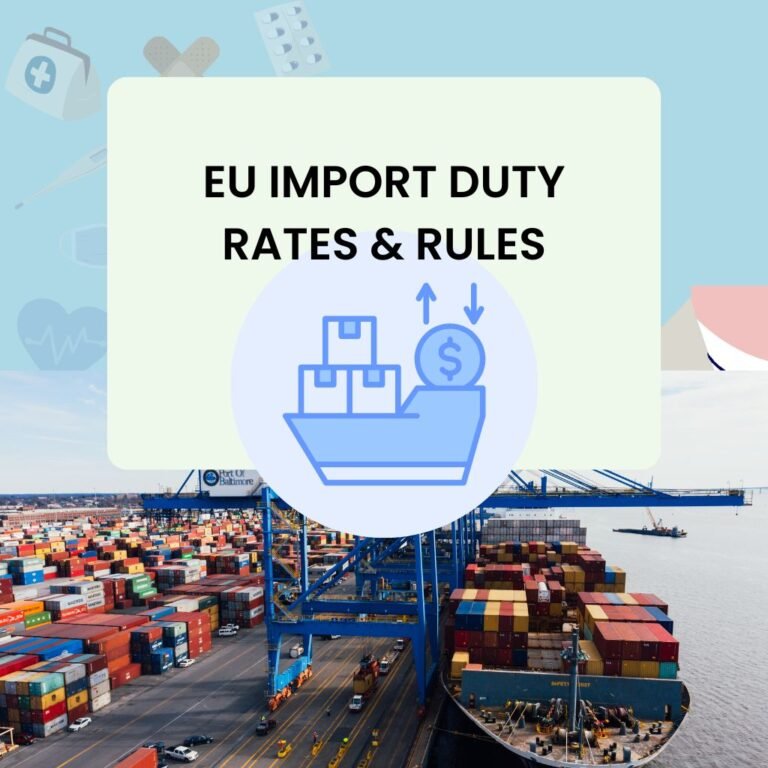Australia Import Duty Rates Explained
Importing goods into Australia is easier than ever — but understanding Australia’s import duty rates, customs duties, and GST on imports is essential to avoid unexpected costs.
Whether you’re a business importing for resale or an online shopper ordering overseas, knowing how the Australian Border Force (ABF) calculates customs charges can save time, money, and confusion.
This guide explains how to calculate import duty and GST on goods to Australia, what exemptions apply under Free Trade Agreements (FTAs), and how to take advantage of duty-free thresholds and tariff concessions.
TOC
Table of Contents
What Are Import Duties and Taxes in Australia?
Import duties and taxes are charges imposed on goods entering Australia to regulate international trade, support local manufacturing, and generate federal revenue. The ABF — part of the Department of Home Affairs — enforces these duties under the Customs Act 1901 and associated tariff schedules.
Customs Duty Explained
Customs duty is a tariff based on the type of product and its tariff classification. It’s calculated as a percentage of the product’s value (usually 5%), although some goods are duty-free under trade agreements or special tariff concessions.
Goods and Services Tax (GST)
GST applies to almost all imported goods at a flat rate of 10%. It’s calculated on the landed cost of the item, which includes:
- Customs value (cost of goods)
- Shipping and insurance
- Import duty
Who Oversees Import Duty?
The Australian Border Force (ABF) administers import duties, verifies declared values, inspects shipments, and enforces customs compliance. The Australian Taxation Office (ATO) manages GST reporting for businesses.
How to Calculate Import Duty and GST on Goods to Australia
Calculating customs charges can seem technical, but it follows a clear, standardized process. Whether you use an Australia import duty calculator or compute it manually, these are the key steps.
Step 1 – Identify the Customs Value
The customs value is typically the CIF value — Cost, Insurance, and Freight. This represents the total cost to deliver the goods to Australia’s border.
For example, if you buy a product for AUD $800 and pay AUD $200 shipping, your customs value is AUD $1,000.
Step 2 – Classify the Product Using HS Codes
Every imported product must be classified under the Australian Customs Tariff, which uses HS (Harmonized System) codes.
Each 8-digit code defines the type of product and its corresponding duty rate.
You can find accurate HS codes in the Working Tariff Document of Australia or the Australian Government Tariff Finder.
Step 3 – Apply the Tariff Rate
Most general goods attract a 5% duty, but the rate depends on the product and origin:
- Electronics and IT goods: 0%
- Apparel and footwear: 5–10%
- Furniture: 5%
- Luxury goods: up to 10% or higher
If your goods come from a Free Trade Agreement (FTA) partner, they may qualify for preferential tariff treatment — often 0%.
Step 4 – Add 10% GST on Imports
The 10% GST applies to the total value of:
(customs value + duty + shipping + insurance)
Even low-value goods (under AUD $1,000) are subject to GST, which must be collected by online sellers like Amazon, eBay, and AliExpress.
Step 5 – Use the Australia Import Duty Calculator
You can use several tools to estimate your customs cost:
- ABF Import Duty Calculator
- Australian Government Tariff Calculator
- Courier duty calculators (DHL, UPS, Australia Post)
These tools automatically apply current duty rates, GST, and FTA preferences.
Example: Calculating Duty and GST
Electronics from the USA
- Declared value: AUD $800
- Duty rate: 0% (CUSMA/US-Australia FTA)
- GST: 10% of $800 = $80
✅ Total payable: $80
Clothing from China
- Declared value: AUD $1,000
- Duty: 5% ($50)
- GST: 10% on $1,050 = $105
✅ Total payable: $155
Furniture from Italy
- Declared value: AUD $2,000
- Duty: 5% ($100)
- GST: 10% on $2,100 = $210
✅ Total payable: $310
Free Trade Agreements and Preferential Tariff Rates
Australia’s network of Free Trade Agreements (FTAs) allows many goods to enter duty-free or at reduced rates.
Australia’s Major FTAs
- AANZFTA – ASEAN-Australia-New Zealand Free Trade Area
- ChAFTA – China-Australia Free Trade Agreement
- JAEPA – Japan-Australia Economic Partnership Agreement
- KAFTA – Korea-Australia Free Trade Agreement
- US-Australia FTA
- UK-Australia FTA (2022)
- CPTPP – Comprehensive and Progressive Agreement for Trans-Pacific Partnership
Rules of Origin
To qualify for preferential rates, goods must originate in an FTA country and meet rules of origin requirements.
Importers must provide a Certificate of Origin or self-certification statement during customs declaration.
Tariff Concession Orders (TCOs)
If an imported product isn’t produced in Australia, importers can apply for a Tariff Concession Order through the Department of Home Affairs to reduce or eliminate duty.
Duty-Free Goods and Import Exemptions
Low-Value Goods Threshold
Goods valued under AUD $1,000 are exempt from import duty, but GST (10%) still applies.
Online platforms registered for GST automatically collect it during checkout.
Traveler Exemptions
Travelers entering Australia are entitled to a duty-free allowance:
- Adults: AUD $900
- Children: AUD $450
- Includes alcohol (2.25L) and limited tobacco products
Items above the limit are taxed on the full value.
Returned and Temporary Imports
Australian-origin goods re-imported without modification are exempt under Item 17 of Schedule 4 of the Customs Tariff.
Temporary imports, such as exhibition samples or professional equipment, can enter duty-free under an ATA Carnet.
Customs Clearance and Required Documentation
Import Declarations
For customs clearance, importers must file an Import Declaration:
- SAC (Self-Assessed Clearance): For low-value imports under AUD $1,000.
- FID (Full Import Declaration): For goods above AUD $1,000 or under special control.
Essential Documents
- Commercial Invoice
- Packing List
- Bill of Lading / Air Waybill
- Certificate of Origin (if applicable)
- Import Declaration (N10/N20)
Inspections and Compliance
The Australian Border Force may inspect shipments to verify declared values, product classifications, and origin.
Accurate HS codes, customs valuation, and FTA certificates are essential to avoid penalties.
How to Reduce Import Duties and Taxes
You can legally minimize your customs costs through strategic import planning.
- Claim FTA Benefits: Check if your products qualify under a free trade agreement to eliminate duty.
- Use Correct HS Codes: Misclassifications can result in overpayment or fines.
- Apply for Tariff Concession Orders (TCOs): Removes duty where local alternatives don’t exist.
- Work With Licensed Customs Brokers: They ensure compliance and optimize cost calculations.
- Consolidate Imports: Reduces processing fees and may qualify for GST efficiencies.
Average Import Duty Rates by Category
| Product Category | Typical Duty Rate | GST (10%) Applies | Notes |
|---|---|---|---|
| Electronics & IT | 0% | ✅ | Duty-free under most FTAs |
| Apparel & Footwear | 5–10% | ✅ | Higher for leather goods |
| Furniture | 5% | ✅ | Based on material type |
| Vehicles | 5% | ✅ | Additional luxury car tax may apply |
| Jewelry & Watches | 5–8% | ✅ | Possible luxury surcharge |
| Food & Beverages | 5–20% | ✅ | Quotas apply for dairy, meat |
Understanding GST on Imports
GST (Goods and Services Tax) applies to nearly all goods imported into Australia, even those under the AUD $1,000 duty-free limit.
Business Imports
Registered businesses can claim input tax credits for GST paid at import when filing their Business Activity Statement (BAS).
Private Imports
Individuals importing goods for personal use cannot claim GST refunds. Online retailers collect GST automatically at checkout for low-value shipments.
Low-Value Goods Reform
Since July 2018, offshore sellers and marketplaces must register for GST if annual sales to Australia exceed AUD $75,000. This ensures fair tax collection between domestic and international sellers.
Recent Trends in Australia’s Import Regulations
Australia’s trade environment continues to modernize, with focus on digitalization, security, and sustainability.
- Digital Trade Modernization Agenda: Introduces paperless clearance and faster border processing.
- Biosecurity Controls: Strengthened to protect Australia’s agriculture and environment.
- Carbon Border Adjustment Mechanisms: Under discussion to align with sustainability goals.
- Expanded FTAs: New partnerships through CPTPP and RCEP expanding duty-free trade zones.
These reforms streamline imports while maintaining strict compliance standards.
FAQs
How much is import duty in Australia?
Most goods have a 5% duty, but many items like electronics are duty-free under FTAs.
What is the GST on imports to Australia?
GST is 10%, applied to the total landed cost including duty, shipping, and insurance.
Are goods under $1,000 duty-free?
Yes, but they still attract 10% GST collected at checkout or by the courier.
How do I know if a product is duty-free?
Check FTA status and use the correct HS code using Australia’s Tariff Finder.
Can I reduce my import taxes legally?
Yes. Use FTAs, apply for concessions, classify goods correctly, and work with brokers.








